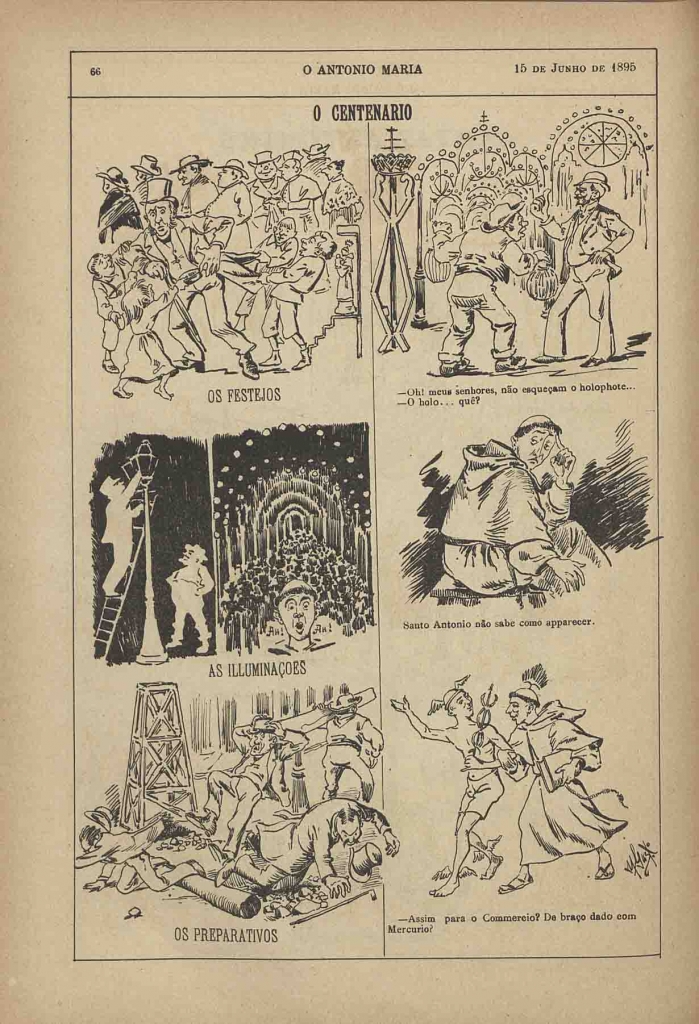Miracle
Santo António por Bordalo
8 of June to 9 of October of 2022

Besides its artistic significance, the graphic artwork of Rafael Bordalo Pinheiro (1846-1905) constitutes an important historical document of the events, customs and mentalities in late-19th century Portugal.
In his humorous newspapers, social and political life was scrutinised from a fundamentally satirical perspective, interspersed, at times, by other articles closer to real reporting.
The feasts of the popular saints [festas dos Santos Populares] that marked the month of June in Lisbon were fertile material for humour. Folk traditions associated with the adoration and feasts were used by Bordalo and his colleagues – such as, his son, Manuel Gustavo – as a metaphor for the behaviour of the political class and the country’s situation. In these caricatures, the Miracle Saint and young women looking for a husband were portrayed with the features of members of the government and opposition to create the “St. Anthonys” of politics.
For the 7th Centenary commemorations to mark the birth of St. Anthony in 1895, Bordalo designed a set of devotional and more prosaic ceramic objects that were caricatural and mass produced at the Fábrica de Faianças das Caldas da Rainha.
Bordalo’s work is a clear testament to the antiquity of the Festas de Lisboa as we know them today. While some traditions have been lost, most are still alive and well.

7th Centenary of St. Anthony 1895
Bordalo was part of Lisbon’s Great Central Committee for the 7th Centenary, which was chaired by Queen Amélia and featured various illustrious figures. However, that did not stop him and his son from producing humorous drawings that were biting critiques of the festivities. In his newspaper O António Maria, they criticised the design of the poster, the poor lighting, the tasteless decor, the ridiculous exhibition of ornamental sacred art, the street party cloaking the statue of King José and, especially, the amateurish allegorical floats and characters in the historical parade, as well as the drawn out and hurried procession due to fear of the anarchists.
The main target was a habitual subject of Bordalo’s satire – the Count of Burnay, the treasurer of the centenary’s executive committee. Bordalo suggested he was responsible for and a financial beneficiary of items purchased abroad, the excessive expense and the organisation of the historical parade, which was the cause of great hilarity and popular derision.

The “St. Anthonys” of politics
For St. Anthony’s Day, Bordalo reserved space in his newspapers for political satire based on the recurrent use of the saint’s iconography. Well-known politicians, some of whom also called Anthony, were depicted, ironically, as “the saint of miracles and weddings”, like António Maria Fontes Pereira de Melo (the head of government), the most popular political “saint”.The scenes comprised allusions to the customs associated with the feast and the cult, such as the collecting donations for candles, the giving of basil with a poem and a paper carnation, the burning of artichokes and an egg in a glass of water, which were all used as metaphors for the state of the country, the government and the people’s reaction to it.
Similarly, Bordalo introduced episodes from the life of St. Anthony, such as the miracle of the fish, into politics, in particular relating to issues of governance in Lisbon.
The devotional practice and the Feasts
In O Arraial de Santo António [St. Anthony Street Party], Bordalo reproduces the electric atmosphere of the festa: great excitement and hubbub with music, dancing, fireworks and a bonfire in a colourful scene decorated with balloons and pears and perfumed with basil and rosemary. Above the illuminated throne stands the image of the “saint of miracles”. Everyone is having fun, the politicians are leaping over the bonfire and Zé Povinho (the personification of the Portuguese people) is playing the guitar enliven the proceedings. In the margin, complementing the scene, are cherries, basil, artichokes and a grasshopper in a cage, as symbols of good fortune. However, the suggestion is that Zé Povinho’s future will not be rosy. Distracted by the party, he fails to notice what is burning on the bonfire the politicians are jumping over. No saint can save him – not St. Anthony, St. John or St. Peter.
Inauguração
8 de junho, 18h00
Duração
8 de junho a 9 de outubro de 2022
Informações
bilheteira@museubordalopinheiro.pt